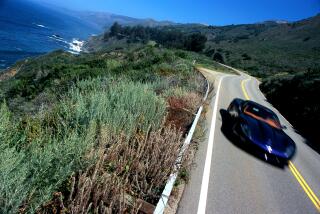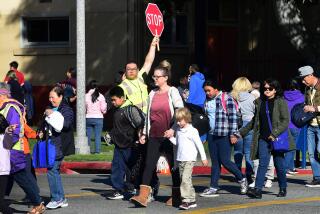What’s the Hitch?
- Share via
A generation ago, a young surfer with a board but no wheels would head for a busy street and stick out his thumb, hoping to hitch a ride to the beach.
Not anymore.
Matt Legault, a 16-year-old car-less surfer from Lakewood, takes the bus.
“I’m always afraid of the weirdos,” said Legault, still dripping from a morning in the waves off Huntington Beach. “My dad says he used to do it when he was a kid, but he’s told me not to.”
This always has been a nation of migrants, from the ancient tribes that crossed over from Asia to the pioneers from Europe, the hobos of the Great Depression and the flower children of the ‘60s.
But during the last 30 years, hitchhiking has all but died out in much of the United States, succumbing to popular perceptions of serial killers trolling the highways for victims and a rising level of national wealth that has given more and more young people access to cars.
“It is rare that we see anybody hitchhiking,” said Lt. Chuck Thomas of the Huntington Beach Police Department, which patrols nearly nine miles of Pacific Coast Highway along some of the state’s best surfing beaches--major hitchhike destinations in past years. “It does happen, but not very frequently.”
Another cause for the decline: The expansion of the federal interstate highway system, which funnels traffic along high-speed pedestrian-less arteries, effectively separating long-distance hitchers from long-distance drivers.
“All life has changed,” said Lewis H. Carlson, retired director of the American Studies program at Western Michigan University. “Hitchhiking was a pretty innocent thing. . . . But you don’t think in those terms anymore.”
1920s Columnist Wrote About Hitchhiking
The modern version of hitching rides evolved in the 1920s as the automobile transformed the nation. The roots of the word itself are unclear. One of its first appearances came in the Nation magazine in 1923, where a columnist identified only as “the Drifter” described meeting “hitchhikers” in northern Vermont--three young New York women who encountered “little trouble and most motorists are pretty good to us” as they thumbed to Montreal.
Their story heartened the Drifter, who “feared that the romance of the road was gone forever” because of the homogenization that came with “National Roads.” Hitchhikers, he wrote, represented a counter-tide.
“Unless human nature has changed--it hasn’t, of course--there begins here a life of the road full of romantic and gallant and even brilliant adventure,” the Drifter wrote.
The romance, though, would give way over time to fear, a transition reflected in popular culture. In the 1953 movie “The Hitch-Hiker,” the title character turns out to be a murderer who commandeers a car carrying two unsuspecting hunters.
Hitching also was woven through rock songs of the ‘60s and ‘70s--the soundtrack to massive social changes. British pop group Vanity Fare reached No. 5 on the U.S. charts with “Hitchin’ a Ride” in 1970, about a man thumbing a ride to “get me home to my baby’s side.” The next year Creedence Clearwater Revival reached No. 6 with “Sweet Hitch-Hiker,” a fantasy about passing an alluring woman on the side of the road.
That same year, though, the Doors’ “Riders on the Storm” described “a killer on the road” warning that “if you give this man a ride, sweet memory will die.”
Warren J. Belasco, chairman of American Studies at the University of Maryland (Baltimore County), thinks the dangers always have lurked behind what he described as the Whitman-esque life on the open road.
“I know women who got raped 30 or 40 years ago, so it wasn’t safe,” said Belasco, 51, adding that his own timidity kept him from hitchhiking as a youth.
Kids More Part of Consumer Culture
Belasco thinks growing consumerism also has lessened the appeal of wandering the nation.
“When I first went to college 30 years ago, I had one trunk,” he said. “Now the kids show up with enormous amounts of possessions. People are more domesticated. There are more things to own. Kids are more a part of the consumer culture.”
Given those changes, generations that once relied on hitchhiking now warn against it.
“I wouldn’t want my grandkids out there hitchhiking,” said Carlson of Western Michigan University. “It’s just a change of attitude as well as the reality of the entire state of our society.”
Carlson said he did most of his hitchhiking in the 1950s, “when a whole generation was on the road.”
“Our attitudes have fundamentally changed,” he said. “There’s a stigma attached to hitchhiking now. Today people are more suspicious of people hitchhiking than they were back then.”
The suspicions cut both ways.
“You never know what situation you’re going to get into when you step into a person’s car,” said Linda Wiley, 30, of Huntington Beach, who admits to hitchhiking once when she was 15 and “was totally stupid.”
The fears are rooted in reality.
Over time, serial killers have entered the modern national consciousness with the crimes of John Wayne Gacy Jr., Ted Bundy and “Son of Sam” David Berkowitz. Southern California also has seen a series of grisly freeway murder sprees, some involving hitchhikers.
There was Patrick Wayne Kearney of Redondo Beach, convicted of cutting up 21 young male victims in the 1970s and leaving their body parts in trash bags along freeways. Then came “freeway killer” William G. Bonin of Downey, who was convicted of killing 14 young men, many of them hitchhikers he picked up in Orange, Los Angeles and Riverside counties.
Next came Randy Kraft, stopped in Mission Viejo in 1983 by police suspicious that he was driving drunk. Kraft initially told officers that the Marine in his passenger seat was a sleeping hitchhiker. When police tried to wake him, they discovered he was dead. Kraft eventually was convicted of 16 murders, some involving hitchhikers.
Legendary Rob Still Thumbing Rides
Yet hitchhiking advocates--and there still are some out there--argue that the “weirdos” have always been there. National paranoia is the difference.
“It’s not as dangerous as one thinks, but it can be creepy,” said an avid hitchhiker who goes by the name Legendary Rob and maintains a Web site detailing his decade of hitchhiking around the country.
He makes his living selling souvenirs and snacks at concert venues and stadiums, and hitchhikes because he doesn’t have a driver’s license and it’s a cheap mode of transportation. He posts Web reports to help people travel “for under $14 a day without getting raped, murdered, arrested or annoyed beyond the limits of your patience.”
But Legendary Rob, who declined to divulge his real name (“I have some personal security issues,” he said), lists Southern California as among the worst places in the country to hitchhike. He blames the population density, the ban on freeway pedestrians and what he calls endemic local paranoia that can leave a hitchhiker stranded for hours.
“Personally, I have made it a rule that if I’m in L.A. County and need to get to other points, I take Amtrak,” he said.
Scott Martelle can be reached by e-mail at Scott.Martelle@latimes.com.
More to Read
Sign up for Essential California
The most important California stories and recommendations in your inbox every morning.
You may occasionally receive promotional content from the Los Angeles Times.











